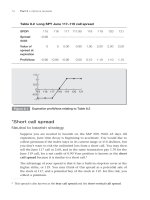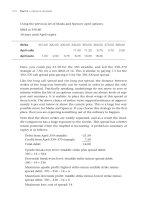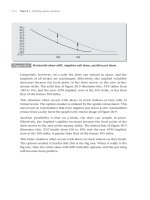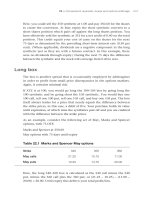CWNA guide to wireless LANs 2nd ch01
Bạn đang xem bản rút gọn của tài liệu. Xem và tải ngay bản đầy đủ của tài liệu tại đây (374.86 KB, 39 trang )
CWNA Guide to Wireless
LANs, Second Edition
Chapter One
It’s a Wireless World
Objectives
• Describe how wireless technology is used in daily
activities
• Tell how wireless local area networks are used in
applications such as education, business, travel,
construction, and other areas
• Explain the advantages and disadvantages of
wireless technology
CWNA Guide to Wireless LANs, Second Edit
2
A Day in the Life of a Wireless User:
Home
• Hotspots: Locations where wireless data services
are available
• Wireless local area network (WLAN): Essentially
identical to standard local area network (LAN)
– Except devices not connected by wires
– Can increase productivity
CWNA Guide to Wireless LANs, Second Edit
3
A Day in the Life of a Wireless User:
Car
• Bluetooth wireless standard: Enables short
range wireless communication
– Used in many small devices
CWNA Guide to Wireless LANs, Second Edit
4
A Day in the Life of a Wireless User:
Office
• Fixed broadband wireless: Wireless
transmissions between immobile devices
– Typically between office buildings
– Utilizes small, customized antennas
• Free space optics (FSO): Alternative to highspeed fiber optic transmissions
CWNA Guide to Wireless LANs, Second Edit
5
A Day in the Life of a Wireless User:
Field
• Handheld devices used to connect to nearest cell
tower
– Cell tower connects to local telephone company
– Telephone company connects to appropriate
resources
• Such as e-mail servers
CWNA Guide to Wireless LANs, Second Edit
6
A Day in the Life of a Wireless User:
On Site
• Radio frequency identification (RFID) tags:
– “Electronic barcodes”
– Used to identify items
– Can be read anywhere within range of transmitted
radio signal
• Depending on device
CWNA Guide to Wireless LANs, Second Edit
7
A Look at Wireless Technologies
• Wireless technology woven throughout many
aspects of life
• Useful to get overview of some current
technologies in today’s wireless world
CWNA Guide to Wireless LANs, Second Edit
8
Wireless Local Area Networks
(WLANs)
• Wi-Fi (Wireless Fidelity): Based on standard that
transmits at up to 11 Mbps
• Computers on WLAN must have wireless network
interface cards (wireless NIC or Wireless
adapter)
– Performs same basic functions as standard NIC,
plus more
• Access point (AP): Transfers signals between
wireless NICs
• Patch cable connects AP to wired LAN or Internet
CWNA Guide to Wireless LANs, Second Edit
9
Wireless Local Area Networks
(continued)
Figure 1-3: Wireless LAN
CWNA Guide to Wireless LANs, Second Edit
10
Wireless Local Area Networks
(continued)
Figure 1-4: Home wireless LAN
CWNA Guide to Wireless LANs, Second Edit
11
Bluetooth
• Low-power wireless data and voice transmission
technology
• Bluetooth devices communicate via radio modules
– Link manager: Software that helps identify other
Bluetooth devices, creates links between devices,
and sends and receives data
• Transmit data at up to 1 Mbps over 10 meters
• Bluetooth devices within range of each other
automatically connect
– Master and slave
CWNA Guide to Wireless LANs, Second Edit
12
Bluetooth (continued)
• Piconet: Bluetooth network containing a master
and at least one slave
Figure 1-5: Bluetooth device
CWNA Guide to Wireless LANs, Second Edit
13
Telecommunications Links
• Integrated Services Digital Networks (ISDN):
Transmits at 256 Kbps
• T-1 lines: Transmit at 1.544 Mbps
• Cable modems: Use television cable connection
• Digital subscriber lines (DSL): Use telephone
lines
• WiMax: Signal transmitted between antennas
– Up to 75 Mbps and over up to 35 miles
– Fixed Broadband
CWNA Guide to Wireless LANs, Second Edit
14
Telecommunications Links (continued)
• FSO: Transmit at speeds up to 1.25 Gbps over up
to 4 miles
– Line-of-site transmission
Figure 1-6: Free space optics transceiver
CWNA Guide to Wireless LANs, Second Edit
15
Telecommunications Links (continued)
Figure 1-7: Wireless office technologies
CWNA Guide to Wireless LANs, Second Edit
16
Cellular Telephony
• Global Systems for Mobile (GSM)
communications technology: Coverage includes
most of US and parts of Europe and Japan
– Transmission speeds up to 9.6 Kbps
– Information transmitted based on Wireless
Application Protocol (WAP)
• Standard way to transmit, format, and display data for
devices like cell phones and handheld devices
CWNA Guide to Wireless LANs, Second Edit
17
Cellular Telephony (continued)
Figure 1-8: Browsing the World Wide Web
CWNA Guide to Wireless LANs, Second Edit
18
Cellular Telephony (continued)
• WAP cell phone runs a microbrowser that uses
Wireless Markup Language (WML) instead of
HTML
• WAP gateway or proxy: Translates between WML
and HTML
Figure 1-9: WAP communications
CWNA Guide to Wireless LANs, Second Edit
19
Radio Frequency Identification (RFID)
• Like an electronic barcode:
– Can contain larger amounts of updatable information
– Information transmitted via radio waves
– Range typically about 1 foot at 5 Mbps
Figure 1-10: RFID tag
CWNA Guide to Wireless LANs, Second Edit
20
Wireless Technology Categories
Table 1-1: Typical wireless technologies
CWNA Guide to Wireless LANs, Second Edit
21
Wireless LAN Applications: Education
• Educational institutions some of first adopters of
WLANs
– Dramatic advantages in teaching and learning
• Wireless LAN connections offer students important
degree of freedom
• WLAN technology translates into cost savings for
colleges
– Reduces need for wiring and infrastructure
– Fewer computer labs necessary
CWNA Guide to Wireless LANs, Second Edit
22
Wireless LAN Applications: Education
(continued)
Figure 1-11: Campus access point locations
CWNA Guide to Wireless LANs, Second Edit
23
Wireless LAN Applications: Business
• Wireless LAN technologies have significantly
changed how business conducted
– Meetings not confined to conference rooms
– Easier to connect to network resources and Internet
– Can create office in space where traditional
infrastructure does not exist
CWNA Guide to Wireless LANs, Second Edit
24
Wireless LAN Applications: Travel
• Travel industry perhaps adopted wireless
technologies more than any other industry
– Many airport terminals provide wireless hotspots
– Several large airlines providing wireless capabilities
to passengers during flights
– Some airlines use WLAN technology to communicate
with aircraft on ground
– Some airlines use WLAN technology to facilitate
maintenance tasks
– Some airlines use new wireless data service to send
and receive messages
CWNA Guide to Wireless LANs, Second Edit
25









